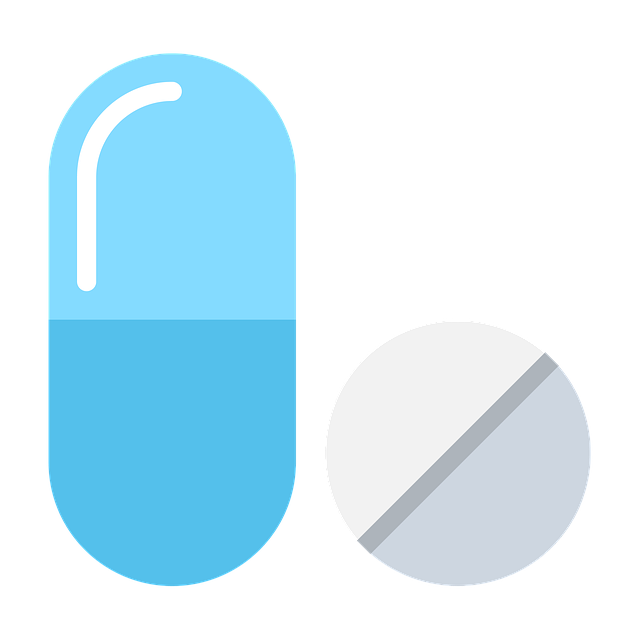Semaglutide, a GLP-1 receptor agonist, is a groundbreaking medication for type 2 diabetes, enhancing blood sugar regulation by stimulating insulin and suppressing glucagon. Dosing begins with lower initial concentrations (e.g., 0.25 mg weekly) to gauge tolerance, gradually titrating up based on patient response. Healthcare providers consider patient factors like medical history, kidney function, and comorbidities for personalized dosing. Regular monitoring during initiation and periodic reassessments for maintenance ensure optimal efficacy while minimizing adverse effects, such as nausea or hypoglycemia. Semaglutide's flexible administration forms (injectable solutions, prefilled pens) cater to individual preferences, with prefilled pens promoting compliance. Continuous evaluation of treatment response through weight, blood pressure, and HbA1c measurements guides dosage adjustments, fostering successful diabetes management. Safety is paramount, requiring close monitoring for side effects and prompt reporting of adverse reactions.
Semaglutide, a glucagon-like peptide-1 (GLP-1) receptor agonist, has revolutionized diabetes management. This article delves into the intricacies of semaglutide dosing, providing a comprehensive guide for healthcare professionals. From understanding the drug’s mechanism to optimizing maintenance dosages and managing side effects, we explore critical factors influencing treatment outcomes. Learn about initial dosing considerations, common administration methods, and strategies for adjusting doses to ensure effective and safe semaglutide therapy.
Understanding Semaglutide: A Glucagon-Like Peptide-1 Receptor Agonist

Semaglutide is a groundbreaking medication that plays a dual role in managing type 2 diabetes. As a Glucagon-Like Peptide-1 (GLP-1) receptor agonist, it mimics the natural hormone GLP-1, which is secreted in response to food intake. This action promotes insulin secretion and suppresses glucagon release, leading to improved blood sugar control. By enhancing the body’s own regulatory mechanisms, semaglutide offers a unique approach to diabetes treatment.
The understanding of semaglutide’s mechanism of action is crucial when considering its optimal dosing. Initial doses are typically lower, allowing the body to adjust and minimizing potential side effects. Gradual titration to the maintenance dose is recommended, ensuring patients can tolerate the medication effectively. This tailored approach to semaglutide dosing contributes to its overall success in lowering blood glucose levels and managing type 2 diabetes.
Initial Dosing of Semaglutide: Factors to Consider

When initiating treatment with semaglutide, several factors come into play in determining the optimal initial dose. The choice should be based on a patient’s medical history, current health status, and specific needs. For instance, patients with type 2 diabetes who are new to semaglutide therapy might start with a lower dose, such as 0.25 mg once weekly, to assess their tolerance and adjust accordingly. This cautious approach is particularly relevant for individuals with comorbidities or those taking other medications that could interact with semaglutide.
Key considerations include patient age, body weight, and kidney function. Patients with advanced kidney disease may require dose adjustments, as semaglutide is primarily excreted renally. Additionally, the presence of certain medical conditions like cardiovascular issues or gastrointestinal disorders might influence dosing. Healthcare providers should regularly monitor patients’ responses during the initial phase to fine-tune the dosage for optimal efficacy and minimal adverse effects.
Optimizing Dosage: Maintenance and Adjustment Strategies

Optimizing dosage is a crucial aspect of successful semaglutide treatment. The initial dose should be carefully selected based on patient factors such as age, weight, and comorbidities. Typically, semaglutide is started at a low dose and gradually increased to avoid adverse effects like nausea or vomiting. Regular monitoring of blood glucose levels during the titration period is essential for finding the optimal dose.
Maintenance and adjustment strategies involve periodic reassessments of patient response and side effects. If the current dose provides adequate glycemic control without significant issues, it may be maintained long-term. However, if suboptimal control or adverse events occur, a dosage adjustment or even a change in treatment modality might be necessary. Health care providers should work closely with patients to make informed decisions regarding semaglutide dosing, tailoring the regimen to individual needs for optimal diabetes management.
Common Dosage Forms and Administration Methods

Semaglutide, a glucagon-like peptide-1 (GLP-1) receptor agonist, is available in various dosage forms and administration methods for both initial and maintenance dosing. The most common formulations include injectable semaglutide solutions and prefilled pens, which offer flexible and convenient dosing options for patients. Initial dosing typically starts with a lower concentration to minimize side effects, such as nausea or vomiting, commonly associated with GLP-1 agonists. Over time, dosages can be gradually increased based on individual patient responses.
For maintenance dosing, healthcare providers often prescribe a stable, consistent dose to effectively manage blood sugar levels. The choice of administration method depends on patient preference and adherence. Injectable solutions require accurate measuring and regular injections, while prefilled pens streamline the process with simple, single-use cartridges, enhancing patient compliance. Understanding these dosage forms and administration methods is crucial for optimal semaglutide therapy, ensuring patients receive the appropriate dose for effective blood sugar control.
Monitoring and Evaluating Treatment Response

Monitoring and evaluating treatment response with semaglutide is crucial for optimizing patient outcomes. Regular assessments, including measurements of key clinical parameters like weight, blood pressure, and HbA1c levels, help in gauging the effectiveness of the therapy. These evaluations are essential for adjusting the semaglutide dosing regimen as needed, ensuring the treatment stays aligned with individual patient needs.
Healthcare providers play a vital role in monitoring patients by scheduling periodic follow-ups and analyzing treatment outcomes. Based on these assessments, they can make informed decisions regarding dosage adjustments or even consider alternative treatments if semaglutide doesn’t yield the desired results. This iterative process is key to fostering a successful treatment journey for individuals managing conditions like type 2 diabetes.
Safety Considerations and Side Effects Management

When considering semaglutide dosing, safety should always be at the forefront. Semaglutide, like any medication, comes with potential side effects that need careful management. Hypoglycemia, for instance, is a risk, particularly when used in conjunction with other glucose-lowering agents. Monitoring blood sugar levels regularly is crucial to mitigate this risk, especially during the initial stages of treatment.
Additionally, gastrointestinal issues are common early side effects of semaglutide due to its impact on appetite and satiety. Nausea, vomiting, and diarrhea may occur but usually subside over time. Effective management involves a gradual adjustment of dosage and proper patient education about expected symptoms. Prompt reporting of adverse reactions by patients is vital for timely intervention and optimization of semaglutide dosing regimens.
